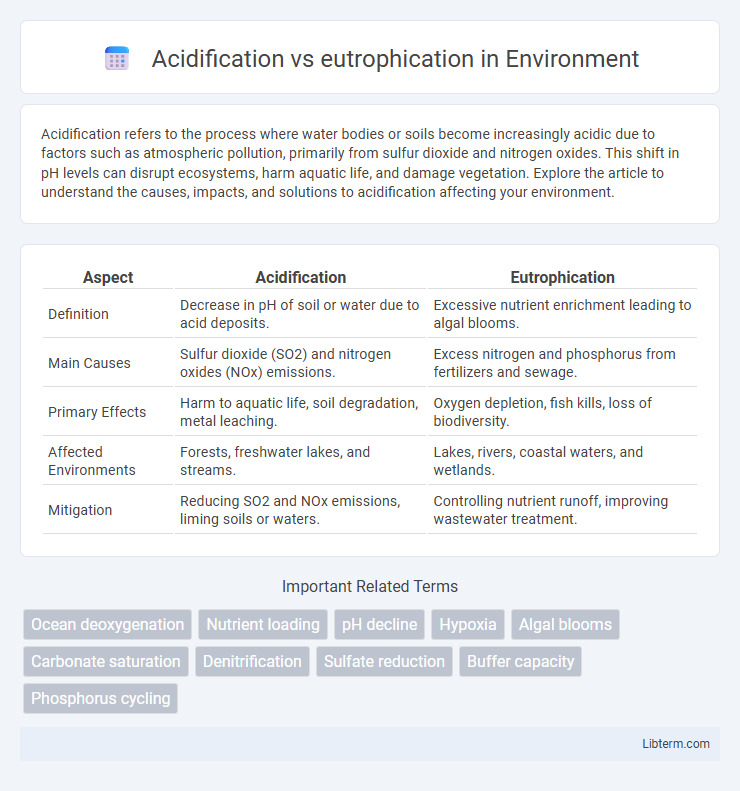Acidification refers to the process where water bodies or soils become increasingly acidic due to factors such as atmospheric pollution, primarily from sulfur dioxide and nitrogen oxides. This shift in pH levels can disrupt ecosystems, harm aquatic life, and damage vegetation. Explore the article to understand the causes, impacts, and solutions to acidification affecting your environment.
Table of Comparison
| Aspect | Acidification | Eutrophication |
|---|---|---|
| Definition | Decrease in pH of soil or water due to acid deposits. | Excessive nutrient enrichment leading to algal blooms. |
| Main Causes | Sulfur dioxide (SO2) and nitrogen oxides (NOx) emissions. | Excess nitrogen and phosphorus from fertilizers and sewage. |
| Primary Effects | Harm to aquatic life, soil degradation, metal leaching. | Oxygen depletion, fish kills, loss of biodiversity. |
| Affected Environments | Forests, freshwater lakes, and streams. | Lakes, rivers, coastal waters, and wetlands. |
| Mitigation | Reducing SO2 and NOx emissions, liming soils or waters. | Controlling nutrient runoff, improving wastewater treatment. |
Introduction to Acidification and Eutrophication
Acidification refers to the process by which ecosystems, particularly aquatic environments, experience increased acidity due to factors like sulfur dioxide and nitrogen oxide emissions that form acid rain. Eutrophication involves the enrichment of water bodies with nutrients such as nitrogen and phosphorus, leading to excessive algal growth and oxygen depletion. Both acidification and eutrophication significantly disrupt aquatic ecosystems, affecting biodiversity, water quality, and ecosystem services.
Defining Acidification: Causes and Effects
Acidification refers to the process by which ecosystems, particularly aquatic and soil environments, experience a decrease in pH due to the absorption of acidic compounds like sulfur dioxide (SO2) and nitrogen oxides (NOx) from industrial emissions. This phenomenon disrupts biological processes by impairing nutrient availability, increasing metal toxicity, and damaging aquatic life through altered water chemistry. Acidification's primary causes include fossil fuel combustion and acid rain, leading to detrimental effects on forest health, freshwater biodiversity, and soil quality.
Understanding Eutrophication: Process and Impacts
Eutrophication is the excessive enrichment of water bodies with nutrients, primarily nitrogen and phosphorus, leading to rapid algal growth and oxygen depletion. This process disrupts aquatic ecosystems by causing hypoxia, fish kills, and loss of biodiversity, severely affecting water quality and aquatic life. Understanding the nutrient sources, such as agricultural runoff and wastewater discharge, is crucial for managing eutrophication and mitigating its environmental impacts.
Key Differences Between Acidification and Eutrophication
Acidification primarily results from the increase of acidic compounds like sulfur dioxide and nitrogen oxides in the atmosphere, leading to lower pH levels in soil and water bodies, whereas eutrophication stems from excessive nutrients, mainly nitrogen and phosphorus, entering aquatic ecosystems and causing algal blooms. Acidification impacts biodiversity by damaging aquatic organisms sensitive to pH changes and leaches essential nutrients from soils, while eutrophication triggers oxygen depletion in water, resulting in dead zones detrimental to fish and other marine life. Monitoring parameters such as pH levels for acidification and nutrient concentrations alongside dissolved oxygen for eutrophication are critical for effective environmental management.
Sources of Acidifying Agents
Acidification primarily results from the release of sulfur dioxide (SO2) and nitrogen oxides (NOx) into the atmosphere, predominantly from fossil fuel combustion in power plants, industrial processes, and vehicle emissions. These acidifying agents transform into sulfuric and nitric acids through atmospheric reactions, leading to acid rain that impacts soil, water bodies, and vegetation. Natural sources such as volcanic emissions also contribute to acidifying agents but to a lesser extent compared to anthropogenic activities.
Nutrient Pollution Leading to Eutrophication
Nutrient pollution primarily from nitrogen and phosphorus compounds accelerates eutrophication by promoting excessive algal growth in aquatic ecosystems. This overabundance of algae depletes oxygen levels as it decomposes, causing hypoxic conditions detrimental to marine and freshwater life. Unlike acidification, which results from increased carbon dioxide levels altering pH balance, eutrophication directly stems from nutrient runoff linked to agricultural fertilizers, sewage discharge, and industrial waste.
Ecological Consequences of Acidification
Acidification leads to decreased pH levels in aquatic ecosystems, causing severe harm to fish populations, invertebrates, and aquatic plants by disrupting reproductive cycles and increasing mortality. It results in soil nutrient imbalances, leaching essential elements like calcium and magnesium, which weakens forest health and biodiversity. Acidified waters also mobilize toxic metals such as aluminum, further stressing aquatic organisms and leading to long-term ecological degradation.
Environmental Impacts of Eutrophication
Eutrophication significantly disrupts aquatic ecosystems by promoting excessive growth of algae and aquatic plants, which depletes oxygen levels and causes dead zones harmful to fish and other marine life. The resulting hypoxic conditions lead to loss of biodiversity, altering food webs and reducing habitat quality. Nutrient loading from agricultural runoff and sewage intensifies these effects, causing long-term damage to water quality and ecosystem resilience.
Mitigation Strategies for Acidification and Eutrophication
Mitigation strategies for acidification emphasize reducing sulfur dioxide (SO2) and nitrogen oxides (NOx) emissions through clean energy technologies and stricter air quality regulations to lower acid rain formation. Eutrophication management focuses on limiting nutrient runoff, primarily nitrogen and phosphorus, by implementing best management practices in agriculture, enhancing wastewater treatment, and restoring wetlands for natural nutrient filtration. Both approaches require integrated monitoring systems and policies that promote sustainable land use to safeguard aquatic ecosystems from acidification and nutrient overload.
Future Challenges and Sustainable Solutions
Acidification and eutrophication present significant future challenges for aquatic ecosystems due to increasing industrial emissions and agricultural runoff, leading to biodiversity loss and altered biogeochemical cycles. Sustainable solutions involve reducing nitrogen and phosphorus inputs through advanced wastewater treatment and promoting carbon sequestration techniques to mitigate acidification effects. Integration of real-time monitoring systems and ecosystem-based management approaches enhances resilience and supports long-term water quality restoration.
Acidification Infographic

 libterm.com
libterm.com